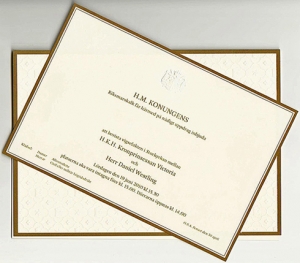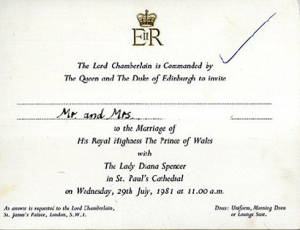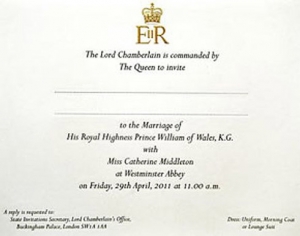How to Address British Royalty & Nobility
See these Related Posts:
–—-—King/Queen
–—-—Duke/Duchess
–—-—Marquess/Marchioness
–—-—Earl/Countess
–—-—Viscount/Viscountess
–—-—Baron/Baroness
–—-—Knight/Dame–—-—Noble Titles: Social Use Only
How to Address an American Citizen Who Is a ‘British Knight’?
When one receives a foreign honor (as in the case with Rudy Giuliani who was knighted by Her Majesty) can he put the OBE after his name as a post nominal? Is he addressed as “Sir Rudy”—–– Sebastian V.
Dear SV:
Knighthoods granted to non-subjects are honorary and are not used as part of their name.
Hence Mr. Giuliani would not include his knighthood’s post nominals with his name …. and is not addressed as Sir Rudy. He would of course include this honor in his bio, and it could be included in a complete introduction. After all, it’s a great honor!
However Elton John and Julie Andrews …. who are subjects (British citizens) …. are correctly addressed in conversation as Sir Elton and Dame Julie and would use their post nominals in complete forms of their name.
– Robert Hickey How to Address British Royalty Nobility

Robert Hickey author of “Honor & Respect”
How to Address a Baroness who is Also a Dame?
I am looking to contact a Baroness who has just been made a Dame (DBE). Specifically – how to write her name in the address block and the salutation in an email.
Which title should I use? Which one takes precedence? Do I use both titles? If so what order?
———–— LAT
Dear LAT,
The British style guides state that those who have a title – are addressed by their title in every instance. E.g., Being a baroness outranks being an Army General, Navy Admiral, Doctor, Professor or Dame. So, address her in the style of a Baroness.
———-The Right Hon.
———-Lady (Name of barony) *
———-(Address)
* With baronies with a compound name – (name one) of/and (name two) – use ‘name one’ when (Name) is specified. Use the ‘compound name’ when the (Complete Name) is specified. The given name of the titled person in never used in formal address.
Style guides also suggest a contemporary practice of addressing a baroness as Baroness (Name) orally …. So use that form in the salutation.
— Robert Hickey

Whose Name First on a Royal Wedding Invitation: Prince William’s or Catherine Middleton’s?
I have been engaged by our local military as a consultant for an event. They want to hold a black-tie dinner to celebrate the marriage of Prince William and Catherine Middleton. I am responsible for most of the arrangements and will provide a dining etiquette presentation to the guests.
I am just putting together the invitations and have written Prince William’s name before Catherine’s. Would you agree? I have been in contact with the office of the private secretary to Prince William on other matters and they have been very helpful but I am to embarrassed to ask them,
I should really know these things. I thought I would ask the expert!
————– Jan C. in Ontario How to Address British Royalty Nobility
Dear Jan C. in Ontario:
Interesting question!
Among commoners typically the bride’s name is first: The parent’s of the bride invite you to the marriage of their daughter to this man, etc. But in this case his name is first since he is royalty.
See the three invitations below. All list the royal person first:
—-#1) The recently married Crown Princess of Sweden to Daniel Westling, a commoner.
—-#2) The Prince of Wales to Diana, who was noble … but not royal like the H.R.H.
—-#3) Prince William to Catherine Middleton.
FYI when I was Belgium and I read a story in Point de Vue, a magazine that focuses on nobility, about the maker of china souvenirs (mugs, plates, etc.) who had already made items with William & Catherine’s initials intertwined … his “W” first …. her “C” second … then destroyed them all. Reason being that WC had the wrong connotation and they redid them with the “C” on top sitting in the open “W” — deemed to be more suitable.
— Robert Hickey How to Address British Royalty Nobility




Robert Hickey author of “Honor & Respect”
How to Address William & Kate?
How should I address a letter to the Their Royal Highnesses Prince William and his bride, Catherine? I want to send a note which is jointly addressed. From what I read there could technically be several correct joint forms, but the best one would be a matter of style: I don’t know which one would be the most preferred:
—-HRH The Prince William
—-and HRH The Princess William
—-TRH The Prince and Princess William
—-HRH The Prince William
—-and HRH The Duchess of Cambridge
—-TRH The Duke and Duchess of Cambridge
—-—-—-—-—-— Royal Watcher
Dear R.W.:
Before I could figure this out, I got this reply from Chris Young, a protocol guru to many of us and a former president of Protocol Diplomacy International – Protocol Officers Association. I could not improve on his explanation. He writes:
—-I would choose
—-—-TRH The Duke and Duchess of Cambridge
Simple reasoning – this is the style the Palace uses with almost complete exclusivity. It is the style on their website, on the Prince of Wales’ website, in the official diaries, in press releases and other correspondence. If it is good enough for Buckingham Palace, then it is good enough for me.
A “duke” is technically lower than a “prince.” However, this is ameliorated by the HRH style. In British royal protocol, the HRH designation is reserved for the Royal Family – and, in specific, these three groups:
—-#1) The sons and daughters of the Sovereign
—-#2) The grandchildren legitimately born by male offspring. This explains why Beatrice and Eugenie, the children of Prince Andrew, Duke of York, are princesses, but Peter and Zara Phillips, the children of Princess Anne, The Princess Royal, are not. A modern exception to this rule is that the children of TRH The Earl and Countess of Wessex (Edward and Sophie) are not styled HRH at the choice of their parents and with consent of the Palace.
—-#3) The children of heirs presumptive, i.e., the children of the eldest son of the Prince of Wales – in this case, any children born to Prince William. (This presents a curious situation, because, technically, any children born to Prince Harry if his father were on the throne would be styled HRH but not if his grandmother were still reigning. The Queen, though, can rectify that by a stroke of her pen.)
Letters patent (an open document issued by a monarch or government conferring a patent or other right) issued by the Queen are often used to grant the title of prince or princess and the style of HRH. (She used this device to create her husband, then Duke Edinburgh, as The Prince Philip in 1957. She likewise created her aunt, Alice, as The Princess Alice in the 1970s.) One such document contemplated your conundrum and described the use of HRH in this way: “This [using HRH] is especially important when a prince holds another title such as duke (or a princess, the title of duchess) by which he or she would normally be addressed. Using the style His (or Her) Royal Highness is directly associated with being a Prince of Princess of the United Kingdom.”
And we see this playing out all the time. Technically Philip is HRH The Prince Philip The Duke of Edinburgh, but he is often referred to, even formally, as HRH The Duke of Edinburgh. In Scotland, Charles is HRH The Duke of Rothesay – not the Prince of Wales. Andrew is always HRH The Duke of York. And Edward is always HRH The Earl of Wessex.
In sum, royal peers (those who hold dukedoms or earldoms) remain princes. However, their peerage is in addition in – never in lieu of – their princely style.
Thank you, Chris!
— Robert Hickey How to Address British Royalty Nobility
Australian, British and Canadian forms of address are related.
See note on use of British spelling in honourable and right honourable.
Robert Hickey author of “Honor & Respect”
When Should You Use the Forms on this Page?
You can use these forms of address for any mode of communication: addressing a letter, invitation, card or Email. (If there are differences between the official and social forms of address, I will have mentioned the different forms.) The form noted in the salutation is the same form you use when you say their name in conversation or when you greet them.
___What I don’t cover on this site are many things I do cover in my book: all the rules of forms of address, about names, international titles, precedence, complimentary closes, details on invitations, place cards, all sorts of introductions, etc. I hope you’ll get a copy of the book if you’d like the further detail.
Not Finding Your Answer?
—-#1) At right on desktops, at the bottom of every page on tablets and phones, is a list of all the offices, officials & topics covered on the site.
—-#2) If you don’t see the official you seek included or your question answered send me an e-mail. I am pretty fast at sending a reply: usually the next day or so (unless I am traveling.) Note: I don’t have mailing or Email addresses for any of the officials and I don’t keep track of offices that exist only in history books.
—-#3) If I think your question is of interest to others, Sometimes I post the question – but always change all the specifics.
— Robert Hickey
Robert Hickey author of “Honor & Respect”
Recommended Resources: The Protocol School of Washington (PSOW) and Protocol and Diplomacy International – Protocol Officers Association (PDI-POA) For more information see the Protocol Resources page.

